Frank Miller’s magnum opus is a creative achievement, but too often misunderstood…

—
The Dark Knight Returns — one of the greatest and most influential comics ever — debuted 35 years ago March 20, making this the anniversary of a major turning point in comics history. To mark the date, we’re publishing two columns: One about the graphic novel’s mixed legacy, by 13th Dimension columnist Fred Van Lente (below), and the other by former DC exec Paul Levitz about the company’s inner workings the day Issue #1 was released (click here). For past commemorations, click here. Dig it. — Dan
—
By FRED VAN LENTE
The Dark Knight Returns isn’t the best Batman story ever. It’s not even Frank Miller’s best Batman story. Hell, it’s not Klaus Janson’s best Batman story. It’s not even the best Iconic-Superhero-Defeats-All-His-Enemies-Then-Fakes-His-Death-And-Retires story published by DC in 1986. (That’d be this one.) Among the triumvirate of 1986’s game-changing graphic novels, it takes home the Bronze behind Watchmen and Maus.
But, cracking it open 35 years since the first time, when I was 14 years old, I could immediately see why it blew everybody’s mind, including mine, when it debuted. Having spent much of that subsequent 35 years engaged in making comics, the thing that impressed me most in 2021 is how evolved Miller is as a comics storyteller.
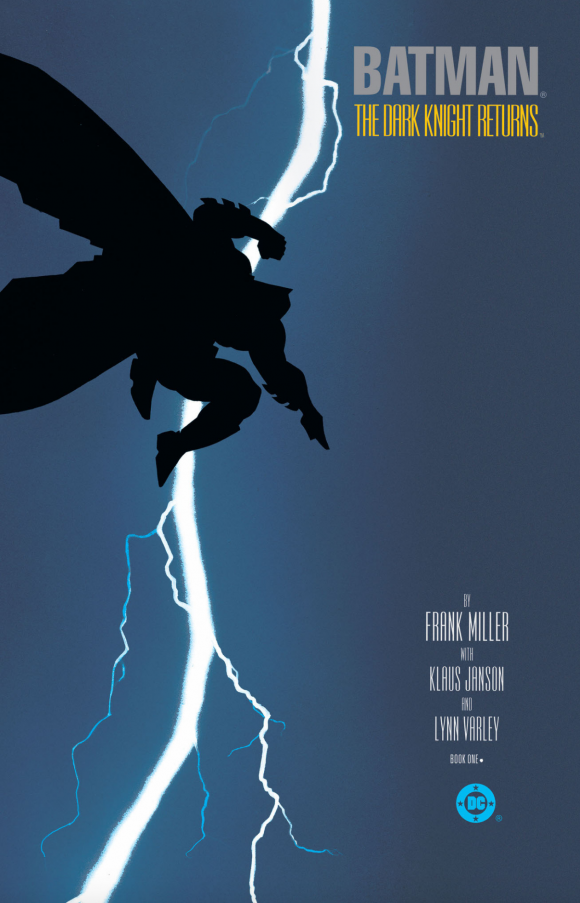
The first successful American creator to be heavily influenced by manga, earlier works like Daredevil and Ronin are full of ninja and samurai; but in DKR he internalizes his Japanese counterparts’ more sublime skills at using page layout to affect the ebb and flow of time.
He uses rapid-fire cuts between individual vignettes, oftentimes just one-panel long, and TV talking heads to speed up time, as in DKR’s most bravura sequence, the return of Batman from his decade-long retirement:
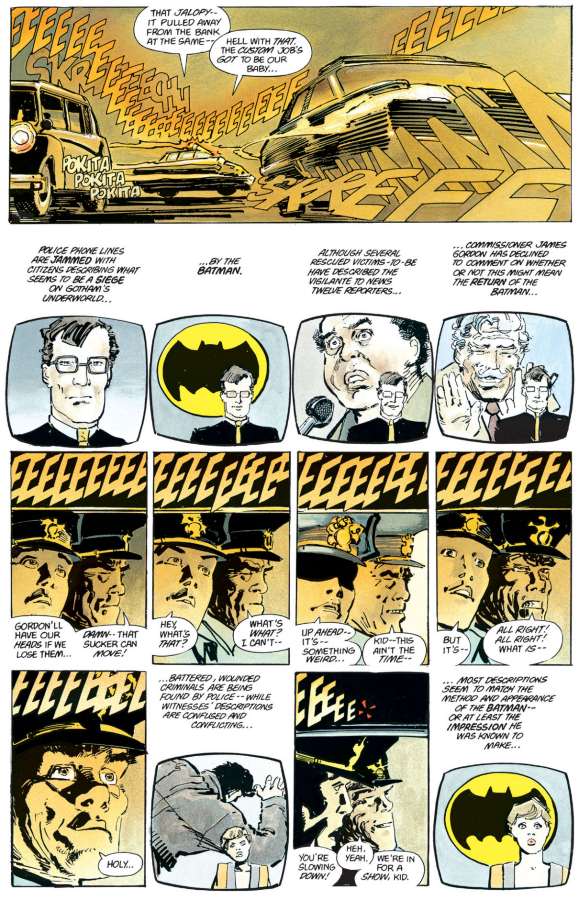
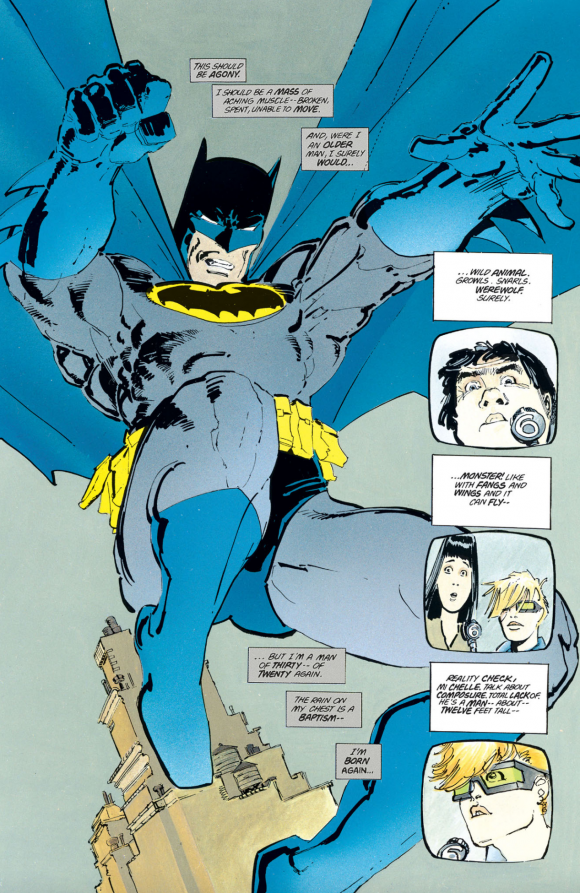
But Miller also uses page layout to the opposite effect, using the careful division of panels and micro-focused moments to slow down time, as seen in his introduction of Joker, Two-Face and Arkham Asylum:
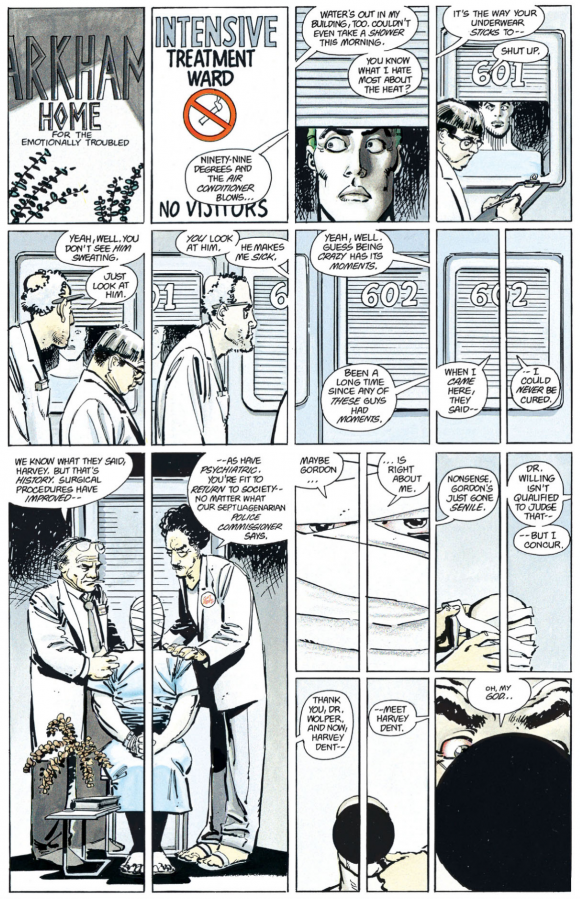
The ideological themes of DKR haven’t aged as well as its formalistic brilliance. As “Arkham Home for the Emotionally Troubled” suggests, Miller’s thesis is that the world has been ruined by limp-wristed liberal sissies and only a real man, I mean, a real Bat-Man, can drag it out of the sewer.
In Bats’ absence the horrific Mutant Gang has overrun Gotham, murdering nuns for kicks. Slimy politicians have made a flunky of Superman, making him do their bidding in exchange for not putting superheroes in camps (or something). Batman wants to believe that a decade-older Two-Face has reformed, but he hasn’t, because people don’t change. A scarred half-dollar never heals. Bad people are just bad, full stop. Mercy is for chumps. Only the strong and uncompromising have a right to rule.
It’s no surprise that Bats gives up on this sick, sad world at the end of the story. He burns Wayne Manor to the ground and goes underground to restart society with a cadre of young paramilitaries who worship him blindly.
Uh, look. You don’t need to be Hannah Arendt to see this is Fascism 101.
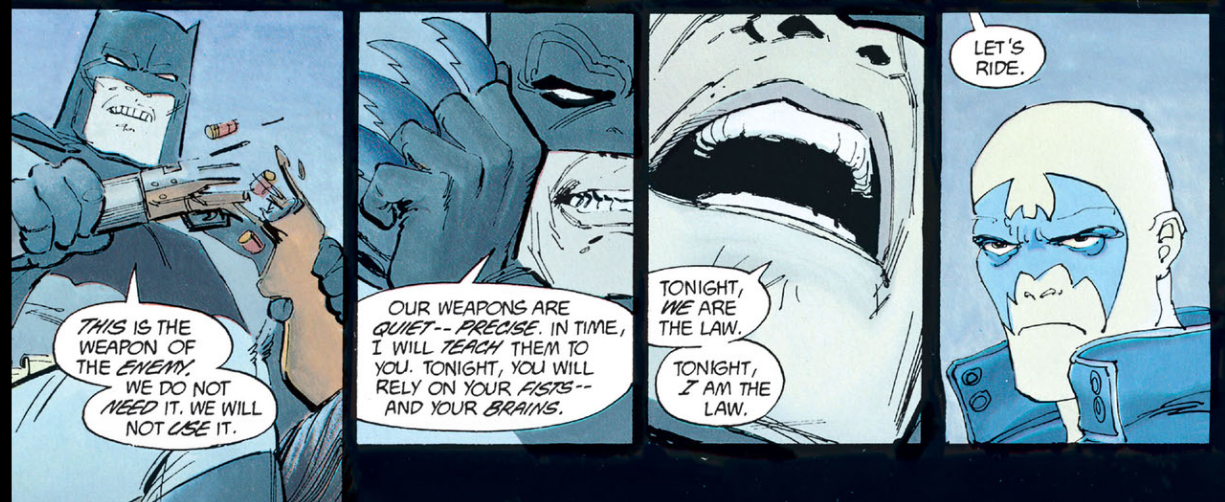
But it’s also not anything you couldn’t see in Clint Eastwood’s Dirty Harry series or Stallone’s Rambo: Vietnam II: This Time the US Wins or any number of 1980s action movies. I suspect that The Dark Knight Returns is more of a product of the pop culture zeitgeist of the Reagan Era than a sincere expression of its creator’s political beliefs, particularly since those have proven rather fungible over the years, much like the rest of us.
What Miller does to Batman isn’t that much different than what Julie Schwartz & co. did to the Flash, Green Lantern, and other All-American heroes at the beginning of the Silver Age: He’s updating their mythos to reflect modern mores. Anyone who complains that DKR ruined superheroes by making them all grim and gritty is looking at the genre in a vacuum. Like a shark, genres that don’t keep moving, die. Just ask the classical mystery, as practiced by Agatha Christie and friends. That’s what the superhero genre was pre-1986, mostly ignored by the general public, except to be trotted out once in a blue moon for meta– and/or kitschy-retro fun.
Yet for all its nun-murdering and Cub Scout-poisoning, DKR insists on, and contrives as a major plot point, the rather old-fashioned idea that Batman refuses to kill. He beats criminals senseless, he throws them through windows, he breaks their bones, he tortures them for information (a lot), he runs them over in a tank, he shoots M60s at them, he inspires a psychopathic cult to murder shoplifters and jaywalkers, but no, no, he’d never kill them. It reminds me of that classic Futurama bit where Fry is aghast at corporations selling ad space in your dreams.
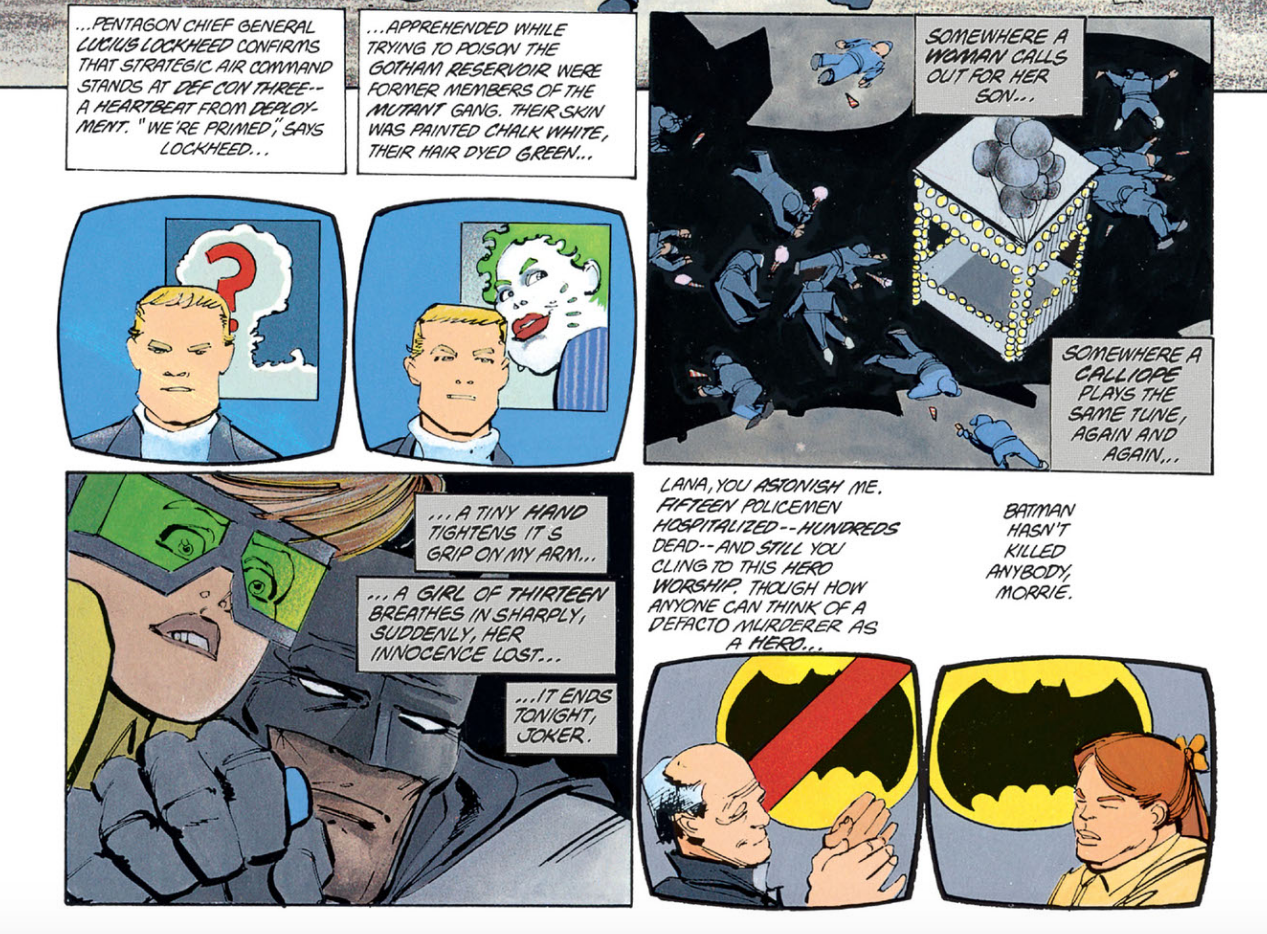
Far be it from me to agree with Zack Snyder about anything, but he’s right that the idea that Batman could exist in the real world without racking up a massive bodycount is, literally, childish. It reminds us that these superhero characters were originally created for the enjoyment of children. If you want to enjoy superheroes as an adult, that’s great. God knows I do, and so do millions of other people. And if because you’re an adult now, you also want Batman to be more “realistic,” absolutely, go for it.
But a lone millionaire with zero superpowers and Q Division gadgets fighting crime and the cops without getting his own hands dirty is the opposite of realistic. It’s bananas. It only makes sense if Batman lives in a bloodless, nerfed world, which DKR decidedly is not.
In many ways it’s a more preposterous concept than Superman himself, who is a god-like being from outer space. For Christopher Reeve’s Superman to work, only he has to be a fantasy. For Adam West’s Batman to work, everything has to be a fantasy.
(Or, you can just chuck the no-killing code whenever it gets in the way of kicking ass, a la Christopher Nolan in the Miller-influenced Batman Begins. Bats delivers the ridiculous line to Ra’s al Ghul, “I won’t kill you, but I don’t have to save you.” Ra’s has already seen Bruce Wayne blow up a castle full of previously-living ninjas at the beginning of the movie, so his holier-than-thou posturing rings particularly hollow.)
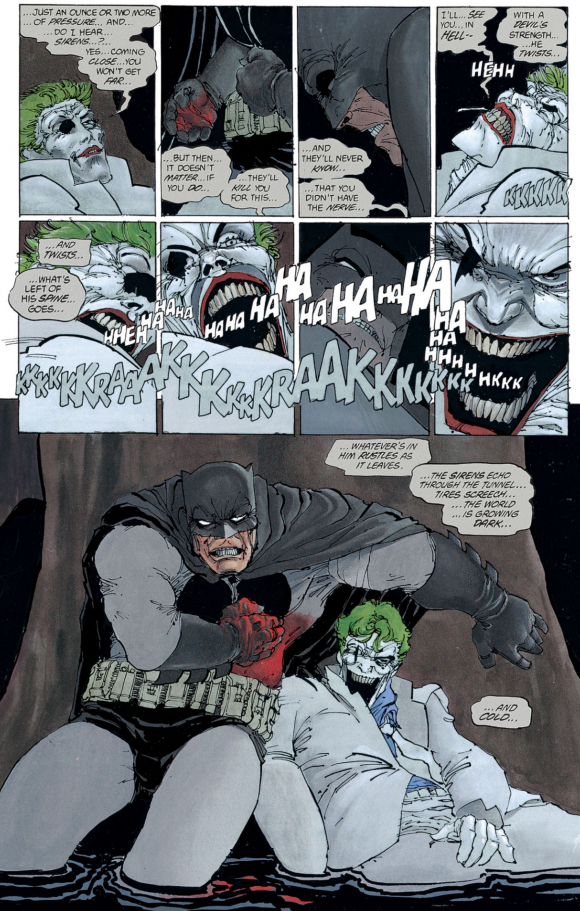
At the end of DKR #3, Joker frames Batman for his own murder, thus making it appear that Bats has violated his I-Don’t-Actually-Kill-People-Myself-But-Otherwise-Everything-Goes code. This makes the US government finally sick of his Bat-Nonsense. A Soviet EMP attack gives President Reagan cover to sic Superman on him amid a nationwide blackout. Miller clearly intends this climax to be the scrappy underdog using brains and skill to defeat a vastly more powerful foe. That’s certainly how I saw it as a teenager, why readers go nuts over it and why we’ve seen it play out over and over ad nauseam since 1986, including in the dueling Marthas of Batman v Superman: Lawsuit of Justice.
As an adult, though, I got to say I’m rooting for Superman.
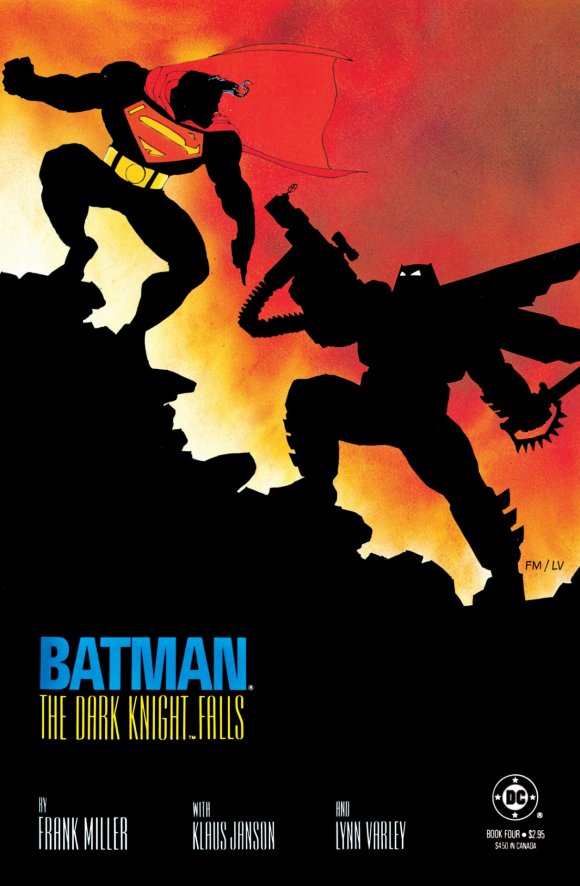
When you grow up, you realize the world teems with Batmen, at least DKR’s version: angry tough guys who break things and push other people around yet always see themselves as the victim.
What the real world needs is more Supermen, people who use what they were born with to help those around them. You act out of care for your adopted home rather than from anger at what your birthright has become. As an adult you recognize that you can’t cure trauma by traumatizing others. You cure it through love.
It’s telling that the protagonists of the major adult superhero works of the 1980s, like Watchmen and DKR (and my personal favorite, O’Neill and Cowan’s The Question), all reach the same conclusion: “You know what? Being a superhero is dumb and probably counter-productive. Let’s stop.” They go on to contribute to society in more substantive, less violent ways. If you’re a Joseph Campbell fan, this is no surprise. The Hero’s Journey is always a coming-of-age story; it’s a passage from youthful exuberance to adult acceptance. The dream becomes reality: less flashy, but more precious, because it’s real.
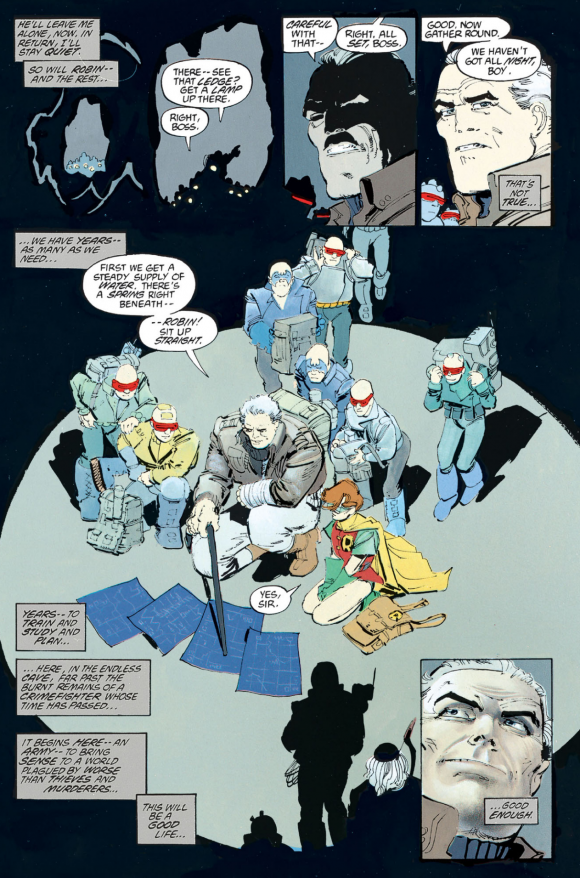
Even old-ass Batman finally grows up and ditches his cape at the end of DKR. Though I can’t help but notice on the last page, that to rebuild civilization, he has brought, by my count, exactly one woman with him.
Who is 13 years old.
So, uh, yeah.
Good luck with that, Bats!
—
MORE
— PAUL LEVITZ: What Happened the Day DC Learned DARK KNIGHT RETURNS Was a Smash. Click here.
— The TOP 13 GREATEST BATMAN STORIES EVER — RANKED. Click here.

March 20, 2021
Enough with the dueling Marthas. I tire of pundits misunderstanding this key moment in BvS. As per Mark Hughes in Forbes –
“The point wasn’t merely that their moms had the same name, it’s that this crystalized for Batman his ability to perceive himself in Superman and to relate completely to Superman’s situation.”
“Which, then, subtly but inherently meant Batman perceived himself as something terrible, truly his own worst nightmare — he’d become the man who killed his own mother, the villain in that dark alley who stood over a helpless little boy and stole his parents from him, letting them die and leaving that boy tortured forever by his inability to do anything to save them. Batman became Joe Chill, and once that comparison burned into his brain it wouldn’t stop. It broke him out of the spell that had taken him over, that obsession with killing Superman to slay the demons in his own soul and feel his life’s pursuits weren’t an absurd hopeless waste of time.”
March 20, 2021
People understand it, we just think it was a remarkably clumsy way of pulling off the idea.
March 20, 2021
Enough with the clueless pundits speech. Everybody understands the intentions of that moment. Nobody has ever overlooked what that moment is intended to do. It’s even a brilliant idea, which is rare in the mess of pretentiousness Snyder gave us. What isn’t brillaint, what pundits and the rest of us criticize is that it all hinges on entirely moronic details. It’s deployed with wooden acting, bad dialogue, and action that builds, against all reason, to this confrontation without ever providing the right context or motivations. Synder missed everything that contributes to every confrontation Bats and Supes ever have. There’s no difference in their methods, their ideologies, or their outlooks. The clash is devoid of a larger meaning, and built on a weak set of circumstances. The flaws of the plot are so egregrious that I can’t list all the reasons, all the mis-characterisations, the plot-holes, the inconsistencies, the trite interactions, that all lead pointlessly to this moment where Bruce screams ‘why did you say that name’ in the worst possible representation of him realising he “became Joe Chill” before blithely going off to murder some more goons. If you don’t see how killing a warehouse full of people undermines everything you just said, I can’t put it any clearer for you, but for the love of comics, please stop pretending we don’t understand this moment. We do. It just wasn’t done well.
March 21, 2021
I think that’s what it was possibly *intended*, or the meaning that others have graciously projected on it. But it was badly done. Really badly done.
The writers discovered at some point that the mothers of Batman and Superman had the same first name, and they were too impressed with their own cleverness and it cost them the effectiveness of that moment.
Superman wouldn’t have called her “Martha” in that moment, and it shouldn’t have been a coincidence of the name that jarred Bruce out of his rage. It’s weird to assume that Bruce would even know his mother’s name or that he would ever call her that.
The writers made it about the fluke chance of shared names, not the critics.
Had he simply begged for his mother’s life, it would have been many times more effective and jarring to Bruce. “He’s going to kill my mom” is so much more potent than “Martha…They’re going to kill Martha…”
But I believe the writers just couldn’t let go of the weird bit of trivia they discovered while researching the characters. That trivia ruined the moment, and recontentualized it into something that audiences and critics quite fairly laughed at.
March 22, 2021
i agree, the “martha’s” thing wasn’t that big a deal, love it or hate it. to be honest at that point in the movie, i thought “oh shit i never realized that”, so maybe im an idiot, but in 40 years of comics reading how much does Martha Wayne’s name really come up? not much. hence it worked on me.
sidenote: earlier today i watched the JL Synder cut – and i think he did a bang up job with both his movies and Man Of Steel was great too. and you certainly cant expect him to copy Marvel’s vibe. i hope he gets to finish his trilogy. i’m tired of hearing people trash BvS.
March 26, 2021
MAD Magazine had the best response: “And lest we forget, both of their LAST names are “-Man”!
March 20, 2021
Let’s not forget the invaluable contribution of Lynn Varley, whose masterfully painted colors truly elevated DKR’s art to whole other levels. I mean, imagine DKR with a stock standard comic book color scheme?!
I feel like too many people miss the fact that this Magnum Opus is, undeniably, a satire as opposed to a straight-up action thriller. It has more in common with the likes of Mad Max 2/The Road Warrior (I mean, the head of the Mutant Gang is very much in the mode of Lord Humongous) & Robocop than, say, Rambo. Miller also has a stab at the popularity of the X-Men (the Mutants complete with Cyclops-style visors) & how they had usurped both Bats & Supes in sales by the 80’s. And he also offers up a lot of commentary on both Batman & Superman’s perception in the media. His Bats may be a more grim n serious version than Adam West on first appearance, but truth be told, he grits so hard it turns him into a near-parody, which is really not that far removed from the over-earnest camp of the 60’s show. As for Miller’s take on Superman, it owes a lot to the Superman of “Superman 2” (film) fame – the one who replaces the US flag on top of the White House despite the very real prospect that the Government may well be corrupt.
I don’t offer any of this commentary to out & out dismiss Miller’s DKR. I actually quite like it & can still recognize it as a groundbreaking work of art. However, I do agree that the socio-political aspects of it have definitely not aged well
March 20, 2021
I am sharing this with everyone I know. Well, not everyone. But those who care. Perfection.
March 20, 2021
This is the best analysis of The Dark Knight Returns I’ve ever read, Fred. If we’re going to build a more empathetic, equal, and sustainable world, we need to start interrogating the stories we’ve long taken as gospel, and storytellers in particular have an obligation to provide a model for sympathetic coexistence in contrast with our current mode of extractive exploitation. I don’t know about you, but I’ll be happy to leave the tough-guy narratives of the Reagan era on the road behind us…
March 22, 2021
Good idea. Let’s leave behind Dark Knight Returns, because it doesn’t fit the ideologies that some (not all) hold dear in 2021. Let’s also leave behind Hamlet, Tom Sawyer, The Odyssey, Frankenstein, Conan, Lovecraft, and all the rest. Let’s just keep whatever gray flannel stories that have been engineered to be as non-offensive as possible to the overwhelmingly cultured peoples of 2021.
The magic of literature (even comics literature) is the use of words (and pictures) to transfer ideas from the writer’s mind to the reader’s. This transference of ideas include the artistic vision of the author, along with the attitudes, excesses, and issues of the day in which they were written. When you strip that all out, in favor of “sympathetic coexistence”, in order to create a world more to the favor of creating “empathy, equality, and sustainability”, you are leaving out the ART part of “art”. You might as well be reading the ingredient label on a package of oatmeal.
True ART is as flawed as it is perfect. It’s as rooted in its’ time as it is timeless. It’s as offensive as it is comforting. Otherwise, why bother?
Your comment, as well as this article, reads as “I love Dark Knight Returns. It’s a classic. If only it wasn’t so Dark Knight Returns, though.”
Have fun reading oatmeal.
March 22, 2021
Tonebone: Permit me an opportunity to clarify, because I would in no way assert that any of the works you cite above — Tom Sawyer, Frankenstein, Citizen Kane, et al. — should be stricken from the cultural canon; quite the opposite. Art provides a window into the folkways of our culture at a given moment in time, so we might accurately measure our intellectual and ethical progress against it. That aspects of some our formative favorites occasionally seem morally questionable in retrospect can arguably be viewed as a heartening epiphany: It’s a marker of the demonstrable progress we’ve made, of the enlightenment we’ve attained, of the sensitivity we’ve cultivated in the span of little more than a single generation.
To that end, I would argue Mr. Van Lente has done an admirable job of placing The Dark Knight Returns in its proper artistic and cultural context here. He both demonstrates and celebrates its aesthetic inventiveness, but reexamines its moral ethos from the perspective afforded to us by the intervening three and a half decades (“The ideological themes of DKR haven’t aged as well as its formalistic brilliance,” he notes). I cannot speak for anyone else here, but I am not suggesting — and have not suggested — The Dark Knight Returns be less “Dark Knight Returnsey.” For me, it is a culturally invaluable snapshot of an ideological outlook — Randian individualism and Reagan-era Might Makes Right — from which I am not unhappy we seem to be (finally) moving beyond.
There is no shortage of commercial fiction being produced right now that both reflects a more enlightened ethos — more inclusive; more compassionate; more aspirational — with an entertainment value considerably higher than you’d find on the nutritional panel of an oatmeal box: The Orville. The Good Place. Schitt’s Creek. Ted Lasso. The narrative arts are a continuum, and each new phase is an extension of and/or reaction to what’s come before. By my appraisal, no one here is suggesting we rewrite Dark Knight Returns to be more in line with latter-day values — that it be retroactively made “less offensive,” or more “woke.” Instead, what I’m suggesting — I won’t speak on Mr. Van Lente’s behalf — is that Miller’s work was a game-changer, it was culturally influential, and we appreciate it still, perhaps now more than ever, because it gives us an insight into human nature we wouldn’t otherwise have without it: that the kind of hero it venerates — the angry tough guy who breaks things and pushes other people around yet always sees himself as the victim — isn’t any kind of “hero” we should aspire to be in 2021.
That’s what I meant when I said there’s value in interrogating the stories we’ve long considered gospel. Interrogation isn’t disavowal; it’s merely the emotionally and intellectually healthy exercise of reexamining the fictions we’ve loved with more experienced eyes and asking ourselves if the values they embody still ring true for us. That’s all. And when they don’t, it’s perfectly okay to acknowledge that and then let them go with gratitude in our hearts for what they showed us about ourselves.
March 20, 2021
Interesting article. A lot of good points but I think you miss the overall point of why this series kicked everyone’s ass: It’s Batman cut loose of all of the commercial and socially acceptable trappings that preceded this story.
It’s also a story from the mid 1980’s, a completely different universe from our world today.
At that time, however, I’d never seen a Batman like that. Was it flawed? Of course – every work of art has flaws, depending upon the viewer. Miller himself took the concepts of this story and blew them up in his Batman and Robin series, bringing Batman to his highest level of asshole-ness. It was too much.
However, in the mid-80’s, after reading years of Batman stories that had never reached even half of the potential for the character, this series completely blew my mind. That’s why it’s still wonderful today when framed in that reference.
March 20, 2021
Brilliant. Well said, with respect, and also maturity.
March 21, 2021
As to your last point, I am sure that there were female members of the mutant gang.
March 21, 2021
Re: last point, it’s not that Wayne and company are planing to start their own civilization. His plan is to create an underground movement/organization to change the world behind the scenes in a more covert way. Think fsociety from Mr. Robot. I would assume that includes recruiting.
March 22, 2021
There were indeed several, including the one standing directly behind him in the image. I’m sure if she had been drawn “obviously female”, Van Lente would have derided that, as well.
March 21, 2021
Great analysis. I agree with most things, specifically with the idea that DKR represents the zeitgeist of that time in history. The way that times and culture have changed impacts on how we read this content nowadays, a time of change and uncertainty.
That being said, some parts of the DKR haven’t aged well, specially considering when an old man, who has selled an image of strong and uncompromising attitude uses paramilitary groups of people who worship him and follow his orders blindly (does the assault of the Capitol sounds familiar?).
This new Era demands a femenine look and approach to the phenomenons, in which care is a fundamental factor in a world that’s falling apart because of the lack of it. Maybe that 13 years old teen that you mentioned has grown up to a woman and can do a better job that her predecessor.
March 22, 2021
I see a lot of comments that “it hasn’t aged well”, and of course the entire premise of the article is that the “cracks are beginning to show”.
This comic was published 35 years ago. Miller did not set out to create a classic. He did not foresee it would become “canon”. He created a comic book. It was printed on nice paper. It had nice coloring. It was about Batman. He did it pretty well.
You cannot blame him for all of those inspired by his book,. Or blame him for the “grim and gritty” movement. Or blame him for DC comics’ constantly moving Batman towards this inevitable future. Or blame him for it influencing Zach Snyder’s awful movies. It’s the fault of all of the creators, directors, etc. who took away the wrong lessons from this story. It’s not Mary Shelley’s fault some dunces still call the monster “Frankenstein”.
The plain and simple facts of the matter are that Miller created a wholly unique version of Batman, Superman and the rest, in a story that told in a way that was as innovative as the story itself. Many of the complaints I see lodged here are akin to picking apart Citizen Kane because it ‘s set in the 1920’s and not in color.
DKR is a product of its time. It was written in 1985 or so, and therefore reflects the social and political milieu of the time. Bernie Getz, the cold war, Reaganism, the media and it’s influence on the world, etc. If you were not a young adult in 1986 (as I was), you would not be able to instantly relate to these things. I, personally, can’t relate to the great depression, but I can get out of my own way long enough to find “The Grapes of Wrath” compelling. I am too young to have cruised in my hotrod, waiting to be drafted to VietNam, but I enjoy “American Grafitti”, and can relate it to my life, in many ways.
It’s not perfect. It never was. But it was completely unlike anything seen before. And I can’t think of anything in comics that has been so earth-shattering, game changing, and influential, since.
March 25, 2021
“You cannot blame him for all of those inspired by his book”
Sure you can. It doesn’t matter what he intended his book to mean. He is responsible for its legacy. That’s not a “fault,” it’s just a fact.
March 20, 2022
Miller has stated that he came up with the Dark Knight Returns while living in New York City in the late 70s when it was run, in the author’s own words, by limp-wristed liberal sissies who coddled criminals and made NYC a virtual hell-hole for people just trying to live their lives. When law and order returned to NYC it became one of America’s safest cities.
Contrast that to today, where unless don’t live here or you get your news from those sources who choose not to report it crime is at an all time high– especially violent crime. Maybe it’s time for another Miller Dark Knight, which was, IMO the greatest superhero opera ever blowing away the over-rated choice cited by the article’s author.
The idea of Batman as a force of nature was innovative at the time and landmark in MIller’s storytelling, which by the way was not based on Manga but on the European comic artists of the time. Miller loved Japanese culture, Kurosawa films, Samurai films, etc, but he has said he found Manga to be “too slowly paced”.
January 27, 2025
So sad are you, mate.
March 21, 2023
I read comics for fun. The Dark Knight was and is a masterpiece in the medium.
The dichotomies of the different characters older versions compared to the younger is fascinating.